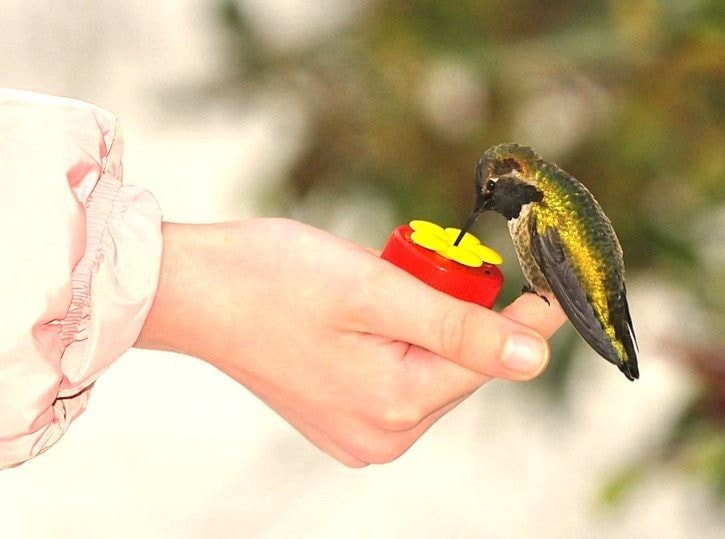The tiny Anna's hummingbirds have become so accustomed overwintering in Chilliwack, they can be spotted flitting at the feeders — even in below freezing temperatures.
Turns out the hardy Anna's variety do not migrate south but tend to stick around.
Gord Gadsden, founder of the Fraser Valley Birding website, said he estimates there are 10 Anna's hummingbirds at his seven feeders in Chilliwack.
Since the cold front moved in earlier this month, it has required some creative feeder tending techniques.
Some Chilliwack bird-watchers have devised wily and ingenious methods to keep their feeder sugar-water solutions from freezing, including wrapping them in Christmas lights, shining a "trouble" light on them or swapping them out before they freeze.
Gadsden said he has to bring his own in every night, and gets up again at first light to put them back out.
As an avid birder he and his five kids make it a project.
 "They are really engaged."
"They are really engaged."
They recently tried out some tiny 'nectar pods' for hand-feeding the hummers.
Katie (in pink) named this one 'Zippy.'
They found the birds would buzz over to perch on their fingers and have a drink form a pod if they were hungry.
"The kids have been having fun helping them survive," Gadsden said. "They're so tiny when they sit on your finger. They're not scared of us at all."
They even get to know each tiny resplendent bird individually as they hover and then park to feed at their respective feeders — or the pods.
"They are fairly territorial and will try to monopolize them."
They usually use 4:1 sugar to water ratio, or a little more sugar when it was below zero.
Many of these hardy little birds would succumb to the elements if people weren't keeping their feeders going, and they come to rely on them.
So why are the Anna's hummingbirds still here?
Gadsden looked into the Anna's and found it's more of a California hummingbird historically.
"They started to expand their range to the north, as exotic plants were flowering later in the season. Our increasingly mild winters has helped. Because conditions weren't as cold in winter as they used to be, they've managed to survive here," he said.
In terms of the Anna's in B.C., they first showed up in Victoria, which is no surprise, as the mildest spot in Canada.
As the winters have been getting milder over the past decade, people started reporting sightings of Anna's in Vancouver, and then in Abbotsford and Chilliwack, as they worked their way eastward.
People associate hummingbirds with the sweet nectar of summer flowers but they have learned to adapt to typically warmer West Coast winters.
At night they go into a hibernation-like torpor, when the heart rate and breathing drop. The metabolism slows.
"When morning comes and the air temperature rises, they will get out there and be looking for nectar."
That's why people are babysitting the precious little ones. They need nectar and lots of it in the cold.
"Some have said on the website they are trying heat lamps, various lights or hand warmers. There are lots of neat tricks on the bird discussion forum," he said. "It's nice to see people coming together and sharing ideas. It takes an investment in time to do this.
"We have to. They are super hungry now. They do eat insects when they're around at 8 or 10 degrees Celsius but now it's all about the feeders."
They become dependent on it, so it requires dedicated feeding.
It's been a big interest topic of interest.
"It's very timely. They are a fascinating little bird.
"They don't give up. They just keep on trucking."
